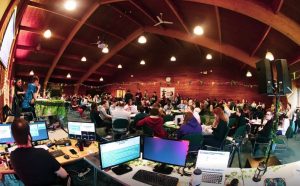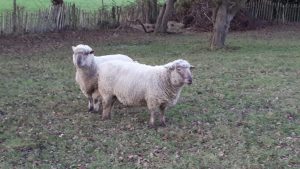Squelching around the manse lawn late in February, I noticed various green shoots of spring, snowdrops and daffodils among them. I had to be careful, to make sure I did not crush them – they were small, and I am not. Stopping to observe them, gave my heart a lift on a wintry day.
Since I last blogged, my diary has afforded me several opportunities to see green shoots of spring in the United Reformed Church (URC).
Young church
 It was my turn to be the General Assembly Moderator at URC Youth Assembly. Derek Estill had told me how much it meant to him in 2019, and I rejoice that it was possible for me to attend this year.
It was my turn to be the General Assembly Moderator at URC Youth Assembly. Derek Estill had told me how much it meant to him in 2019, and I rejoice that it was possible for me to attend this year.
I was struck time and again by the passionate consideration of some diverse business:
- care for URC people who are university students;
- a reasoned and bold reaction to a current ecumenical issue that affects all the denominations in Churches Together in England;
- recognition that the world is in a climate emergency and a challenge to the whole URC to make events eco-friendly; and
- interest in a youth-focussed celebration of the URC’s 50th anniversary.
In search of common ground (the event’s theme), Youth Assembly was punctuated by the earnest examination of three big issues: sex, faith and relationships; war; and politics.
There was worship that was at once both thoughtful and vibrant. There was a warm and generous spirit through it all.
And the leadership of the moderators and the moderator-elect, with their colleagues, was a moving mix of carefully prepared steady hand and (seemingly) unflappable spontaneity. In fact, it seemed to me that Youth Assembly was less a green shoot of spring than a life-giving organ of the URC.
Eco church
 The following Sunday I was leading worship at St John’s URC in Marsh Green, Kent. I was presenting A Rocha’s Eco Church Gold Award, which St John’s had recently become the first URC to achieve.
The following Sunday I was leading worship at St John’s URC in Marsh Green, Kent. I was presenting A Rocha’s Eco Church Gold Award, which St John’s had recently become the first URC to achieve.
Its commitment to the environment is movingly inspired, as stated on its website: “Every time we baptise a new baby we are reminded of the state of the planet on which they (and children the world over) must live; they are the ones who are going to ‘inherit the earth’ however damaged it is.”
The church has spent some years working on installing photovoltaic panels to become a net exporter of electricity, and a rainwater tank that flushes the toilets and another that waters the plants. There’s a nature reserve, with a wildflower meadow grazed by sheep loaned by a local farmer, fruit trees and numerous bird, bat, bug and butterfly boxes, and a whole lot more. As members make clear: “The church’s environmental work is a continuous process since moving forward is essential if we are to play our part in passing on a world to our children that is fit to live in.” The next chapter is to encourage the entire village to become hedgehog friendly. These were literally green shoots – for a local church that in its modest size is thriving, and for our world to which this is making a difference.
New church
 A couple of weeks later, with Quentin Milan-Laguerre, a French theological student on placement with us in Cambridge, I visited some more green shoots in West Thamesmead. When the sprawling south-east London housing estate was established, churches were carefully inaugurated in the east, south and north, but not in the west. Just as the URC had taken its place in those other ecumenical causes, so a more recent church plant has begun to take root in the west, meeting in homes and on Sundays in a school.
A couple of weeks later, with Quentin Milan-Laguerre, a French theological student on placement with us in Cambridge, I visited some more green shoots in West Thamesmead. When the sprawling south-east London housing estate was established, churches were carefully inaugurated in the east, south and north, but not in the west. Just as the URC had taken its place in those other ecumenical causes, so a more recent church plant has begun to take root in the west, meeting in homes and on Sundays in a school.
With serious pump priming from the URC’s Southern Synod, alongside the faith-filled and energetic ministry of the Revds Andrew and Sally Willett, a church is emerging. As the poster suggests, children are at its heart, but they are not throbbing there alone. A young people’s ministry thrives at the manse, where around 15 teenagers gather every week, and this embryonic church also has four people praying about their vocation to some assort of ministry.
It’s not easy work and there are real challenges in many ways, but such has always been the authentic living out of the Gospel. As by hard work and prayer seeds are sown and watered, so green shoots are being brought to growth. Surely, they witness to God, who is “ever faithful, ever sure.”
Old church
 And finally, Fulbourn URC is one of the rural chapels that I am privileged to serve as part of the Cambridgeshire pastorate I came to in 2010. It knows what it is to have small congregations Sunday by Sunday. It understands the challenges of maintaining its 19th century buildings and is grateful for Eastern Synod’s help with that. Fulbourn URC also faces the succession planning questions so inevitable for an ageing membership.
And finally, Fulbourn URC is one of the rural chapels that I am privileged to serve as part of the Cambridgeshire pastorate I came to in 2010. It knows what it is to have small congregations Sunday by Sunday. It understands the challenges of maintaining its 19th century buildings and is grateful for Eastern Synod’s help with that. Fulbourn URC also faces the succession planning questions so inevitable for an ageing membership.
And yet … in six weeks it raised over £1200 for charity. Benefitting from villagers’ great support, it gave its Christmas offertories to a hospice and to work among children in hospital, and then, at the beginning of February, raised more than £500 at a coffee morning in aid of toilet twinning.
People seemed to be inspired by the opportunity to afford dignity and safety to strangers far, far away who otherwise have nothing of the lavatory provision we so take for granted. Green shoots of love in action.
Spending a month moving around these green shoots of new life around the United Reformed Church was true joy. We have to be careful, to make sure we do not crush them with neglect, discouragement or failure to build upon or resource them. But the truth for me is this, stopping to observe them gave my heart a lift on wintry days, and I can only say thank you to each person involved, and “to God alone be the glory”.
P.S. Since writing this blog, the flooding in various parts of the UK, and the global development of the Covid 19 virus have filled the headlines. Part of our Lenten discipline could be to include them in our prayers as well.
Nigel Uden, March 2020
